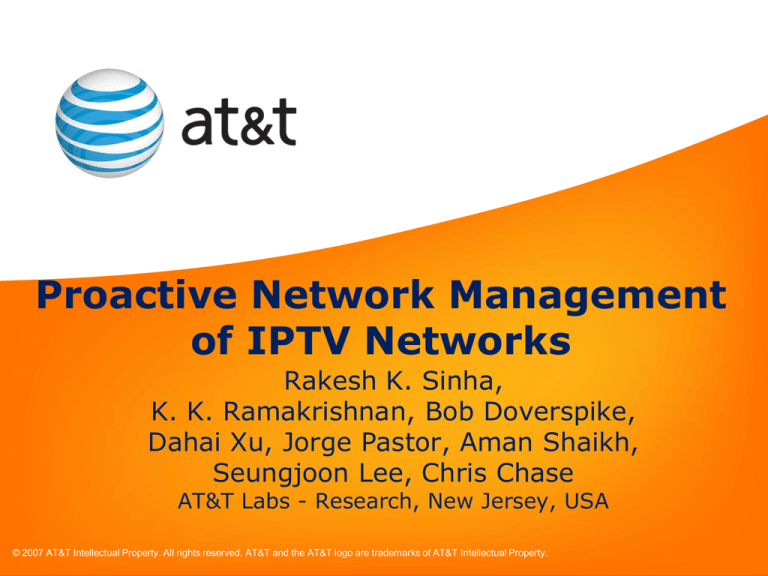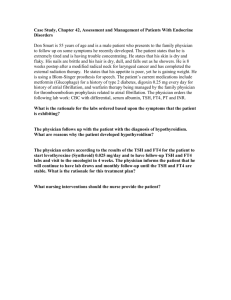
Proactive Network Management
of IPTV Networks
Rakesh K. Sinha,
K. K. Ramakrishnan, Bob Doverspike,
Dahai Xu, Jorge Pastor, Aman Shaikh,
Seungjoon Lee, Chris Chase
AT&T Labs - Research, New Jersey, USA
© 2007 AT&T Intellectual Property. All rights reserved. AT&T and the AT&T logo are trademarks of AT&T Intellectual Property.
IPTV service
• High visibility: direct customer impact.
• Service is very sensitive to delay and packet loss
•
Congestion on links -> packet loss-> video quality impairment
•
Need to tackle multiple failures, which are not very rare.
•
Higher layer mechanisms - FEC, retransmission based recovery
of lost packets - can handle (with reasonable delays), burst
losses of about 50 milliseconds
–
Fast restoration is critical
AT&T’s IPTV service:
–
–
Page 3
2+ million customers;
Triple play: video, internet, and voice
Network backbone
• One Video hub office (VHO) per metro area
• National content is acquired at Super hub office (SHO)
• Content is distributed to VHOs using single source specific
mode multicast tree
(PIM-SSM)
–
a separate multicast tree
for each channel
SHO
VHO
VHO
Long Distance
Backbone
VHO
VHO
VHO
VHO
VHO
VHO
VHO
Details in 2009
VHO
Router
Metro Intermediate Office
‘IEEE Internet
Computing’ Paper
Page 4
S/VHO = Super/Video Hub Office
Video Serving Office
RG
Set-top
Box
DSLAM = Digital Subscriber
Loop Access Multiplexer
Metro Area
Access
RG RG = Residential Gateway
Local Link-Based Fast Re-Route (FRR)
A
Backup
Path
B
“Virtual link” between AB with virtual interfaces
Virtual link consists of both a primary and backup
Path: The OSPF topology (and multicast tree) built on top of the
virtual link
7
FRR example on virtual link (10,11)
Normal traffic forwarded on primary link (10,11)
When primary link fails, link layer mechanism using FRR
switches to backup
No OSPF/PIM-SSM convergence required
28
3
5
8
9
23
22
1
10
6
4
13
2
11
16
24
14
2
17
19
7
Back up path
12
18
15
8
20
Challenges in implementing IPTV services
Due to high sensitivity of IPTV service, must plan for
•
multiple, concurrent outages
•
In a study of link outages over 4 months, we found that
in 17% of cases, at least 2 links were down concurrently.
•
IP Multicast results in a very efficient network -> smaller
overbuild capacity -> requires more careful multi-layer
restoration planning, design, and management.
•
Because FRR is invisible to IGP/PIM, these protocols can
potentially interact in a ‘bad’ way creating congestion in
the network.
Page 9
Our approach
•
Be proactive in dealing with the effect of multiple failures
•
Maintenance activity is often planned far in advance and is often
agnostic to real-time network state
We coordinate planned network maintenance activity with real-
•
time network state.
Need a comprehensive view across many different network layers.
•
•
Example (details later): an SNMP based tool can tell when a link is
congested but by looking at a variety of data sources, we can
pinpoint to one of 3 or 4 different reasons for link congestion.
Page 10
Dealing w/ Network component failures
• (Reactive) Use FRR whenever backup path is available; Use
IGP otherwise. There is potential for congestion with
multiple failures
overlap of two FRR paths, OR
• overlap of FRR path with multicast tree.
•
• (Proactive) Avoid potential overlap by using a cross-layer
approach to reconfigure the multicast tree after a
successful FRR event. [COMSNETS 2010]
Another issue:
state. E.g,
Alert the operator to any changes in network
• An FRR event may reroute traffic to a different set of links
• A PIM re-convergence may alter the multicast tree
Page 11
Dealing w/ Network maintenance
Maintenance activity is often planned far in advance and is
•
often agnostic to real-time network state
•
Coordinate planned network maintenance activity with
real-time network state. Examples
•
any link carrying traffic should not have a maintenance
activity
•
IPTV networks are typically shared as an access network
providing Internet connectivity to customers and a pair of
routers within a metro office maintain BGP sessions with ISP
edge routers. If one of these BGP sessions is down, its
‘mate’ router should not be touched.
Page 12
Pinpoint the cause of link congestion
• An SNMP based tool can point out which links are
congested. However knowing the underlying cause can for
congestion gives an insight in how to fix it.
• Holistic view needed to disambiguate cause
• Different ways that a link can get congested
•
Oversubscribed? Too many TV channels/VoD
•
Overlap between different FRR paths and/or multicast tree
•
Lots of parallel links between offices and sometimes we can get
load imbalance: high bandwidth channels on one link and low
bandwidth channels on the other link.
Page 13
Multiple views of the network
• NetDB tool (developed at AT&T Research): parses router
configuration files to build failure-free topology
•
OSPFMon tool (developed at AT&T Research): establishes a
partial adjacency with one or more routers to receive LSAs
and create a real-time topology
•
FRR is invisible to IGP and may appear self-healing but it
alters the network state significantly
Need logic to infer that successful FRR has happened
– Use NetDB to get links in the back-up path being used
–
•
MRTG tool: collects link utilizations
•
BGP reachability: compare number of routes to a threshold;
also monitor various alarms
•
Operations Support System: list of links scheduled to
undergo maintenance during the next 24 hours.
Page 14
Web based visualization tool: Birdseye
Synthesizes and interprets data from a variety of data sources to
obtain a comprehensive network view. Our overall philosophy
is to
• Maintain an idealized, failure-free state
–
List of links and routers, link capacities, multicast tree, FRR backup
paths, etc.
• Maintain real-time state
–
–
Real-time topology, link utilization, BGP reachability, database of
links planned for scheduled maintenance
Either directly from tools or by interpreting data from multiple tools.
• Parse the differences and show necessary alerts to the
operator
• Has been in use in AT&T Network Operations Center for 1+ yr.
Page 15
Sample GUI snapshot: triple link failure
TO PROTECT PROPRIETARY
INFORMATION THIS DOES NOT
DEPICT AN ACTUAL NETWORK
OR OUTAGE
Page 16
Sample snapshot: updated multicast tree
TO PROTECT PROPRIETARY
INFORMATION THIS DOES NOT
DEPICT AN ACTUAL NETWORK
OR OUTAGE
Page 17
Conclusion
• IPTV services have high sensitivity to impairments and high
visibility in terms of customer impact
• Need careful designing of network protocols to deal with
multiple failures
• Operators need a comprehensive view of the network
•
Our Birdseye tool distills network data from multiple AT&Tdeveloped systems and public tools and domain knowledge of
networking protocols to compile a holistic view to the operators
•
Has been in use at Network Operation Center for over a year for
a service with 2+ million customers
Page 18




